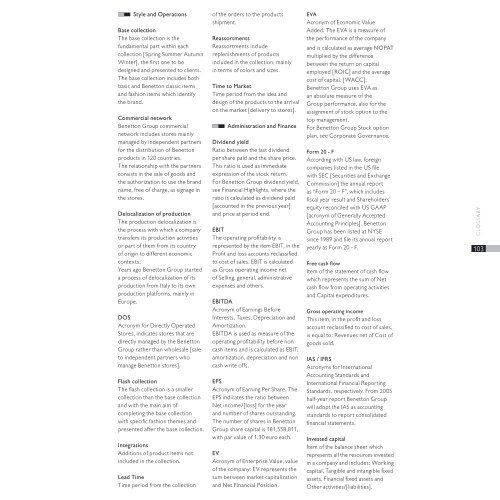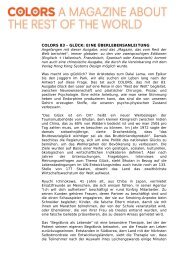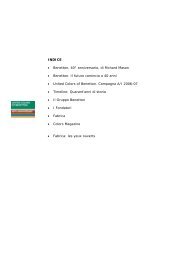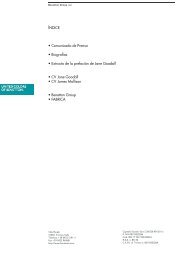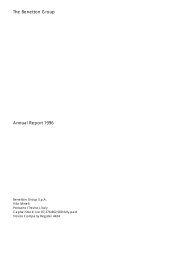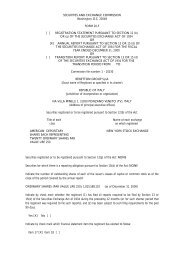2004 Annual Report - Benetton Group
2004 Annual Report - Benetton Group
2004 Annual Report - Benetton Group
You also want an ePaper? Increase the reach of your titles
YUMPU automatically turns print PDFs into web optimized ePapers that Google loves.
Style and Operations<br />
Base collection<br />
The base collection is the<br />
fundamental part within each<br />
collection [Spring Summer Autumn<br />
Winter], the first one to be<br />
designed and presented to clients.<br />
The base collection includes both<br />
basic and <strong>Benetton</strong> classic items<br />
and fashion items which identify<br />
the brand.<br />
Commercial network<br />
<strong>Benetton</strong> <strong>Group</strong> commercial<br />
network includes stores mainly<br />
managed by independent partners<br />
for the distribution of <strong>Benetton</strong><br />
products in 120 countries.<br />
The relationship with the partners<br />
consists in the sale of goods and<br />
the authorization to use the brand<br />
name, free of charge, as signage in<br />
the stores.<br />
Delocalization of production<br />
The production delocalization is<br />
the process with which a company<br />
transfers its production activities<br />
or part of them from its country<br />
of origin to different economic<br />
contexts.<br />
Years ago <strong>Benetton</strong> <strong>Group</strong> started<br />
a process of delocalization of its<br />
production from Italy to its own<br />
production platforms, mainly in<br />
Europe.<br />
DOS<br />
Acronym for Directly Operated<br />
Stores, indicates stores that are<br />
directly managed by the <strong>Benetton</strong><br />
<strong>Group</strong> rather than wholesale [sale<br />
to independent partners who<br />
manage <strong>Benetton</strong> stores].<br />
Flash collection<br />
The flash collection is a smaller<br />
collection than the base collection<br />
and with the main aim of<br />
completing the base collection<br />
with specific fashion themes and<br />
presented after the base collection.<br />
Integrations<br />
Additions of product items not<br />
included in the collection.<br />
Lead Time<br />
Time period from the collection<br />
of the orders to the products<br />
shipment.<br />
Reassortments<br />
Reassortments include<br />
replenishments of products<br />
included in the collection, mainly<br />
in terms of colors and sizes.<br />
Time to Market<br />
Time period from the idea and<br />
design of the products to the arrival<br />
on the market [delivery to stores].<br />
Administration and Finance<br />
Dividend yield<br />
Ratio between the last dividend<br />
per share paid and the share price.<br />
This ratio is used as immediate<br />
expression of the stock return.<br />
For <strong>Benetton</strong> <strong>Group</strong> dividend yield,<br />
see Financial Highlights, where the<br />
ratio is calculated as dividend paid<br />
[accounted in the previous year]<br />
and price at period end.<br />
EBIT<br />
The operating profitability is<br />
represented by the item EBIT, in the<br />
Profit and loss accounts reclassified<br />
to cost of sales. EBIT is calculated<br />
as Gross operating income net<br />
of Selling, general, administrative<br />
expenses and others.<br />
EBITDA<br />
Acronym of Earnings Before<br />
Interests, Taxes, Depreciation and<br />
Amortization.<br />
EBITDA is used as measure of the<br />
operating profitability before non<br />
cash items and is calculated as EBIT,<br />
amortization, depreciation and non<br />
cash write offs.<br />
EPS<br />
Acronym of Earning Per Share. The<br />
EPS indicates the ratio between<br />
Net income/[loss] for the year<br />
and number of shares outstanding.<br />
The number of shares in <strong>Benetton</strong><br />
<strong>Group</strong> share capital is 181,558,811,<br />
with par value of 1.30 euro each.<br />
EV<br />
Acronym of Enterprise Value, value<br />
of the company: EV represents the<br />
sum between market capitalization<br />
and Net Financial Position.<br />
EVA<br />
Acronym of Economic Value<br />
Added. The EVA is a measure of<br />
the performance of the company<br />
and is calculated as average NOPAT<br />
multiplied by the difference<br />
between the return on capital<br />
employed [ROIC] and the average<br />
cost of capital. [WACC].<br />
<strong>Benetton</strong> <strong>Group</strong> uses EVA as<br />
an absolute measure of the<br />
<strong>Group</strong> performance, also for the<br />
assignment of stock option to the<br />
top management.<br />
For <strong>Benetton</strong> <strong>Group</strong> Stock option<br />
plan, see Corporate Governance.<br />
Form 20 - F<br />
According with US law, foreign<br />
companies listed in the US file<br />
with SEC [Securities and Exchange<br />
Commission] the annual report<br />
as “Form 20 – F”, which includes<br />
fiscal year result and Shareholders’<br />
equity reconciled with US GAAP<br />
[acronym of Generally Accepted<br />
Accounting Principles]. <strong>Benetton</strong><br />
<strong>Group</strong> has been listed at NYSE<br />
since 1989 and file its annual report<br />
yearly as Form 20 - F.<br />
Free cash flow<br />
Item of the statement of cash flow<br />
which represents the sum of Net<br />
cash flow from operating activities<br />
and Capital expenditures.<br />
Gross operating income<br />
This item, in the profit and loss<br />
account reclassified to cost of sales,<br />
is equal to: Revenues net of Cost of<br />
goods sold.<br />
IAS / IFRS<br />
Acronyms for International<br />
Accounting Standards and<br />
International Financial <strong>Report</strong>ing<br />
Standards, respectively. From 2005<br />
half-year report <strong>Benetton</strong> <strong>Group</strong><br />
will adopt the IAS as accounting<br />
standards to report consolidated<br />
financial statements.<br />
Invested capital<br />
Item of the balance sheet which<br />
represents all the resources invested<br />
in a company and includes: Working<br />
capital, Tangible and intangible fixed<br />
assets, Financial fixed assets and<br />
Other activities/[liabilities].<br />
G LOSSA RY<br />
103


